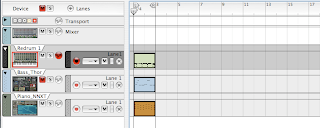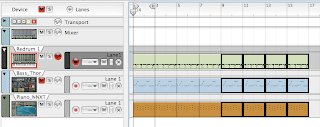
Materials:
• Computer with internet connection and speakers
• Song examples
Discussion:
Now that we know our way around the keyboard and most of the instruments in Reason, let’s take a little time to really learn about how songs are put together...
There are lots of different ways you can structure music and different types of music tend to have their own rules about it. Generally speaking, in most types of popular music, you have two or more parts that trade off, and repeat throughout the song. Why do you think this happens?
Here are a couple reasons:
1. Repetition - people tend to like it when they hear a part of a song that they have heard before. Since they remember it and know how it's going to go, that helps them to sing along, dance, and experience the music.
2. Variety - If you just repeat the same part over and over again, it gets boring pretty fast! But if you switch it up a little by having a couple of different parts trading off, you can keep things fresh and interesting for the listener.
Today, we're going to look at two particular parts: the Verse and the Chorus.
The Verse
• is the part of the song where the story is told.
• The lyrics usually change from verse to verse, but the instrumental (rhythm and melody) generally stays the same.
• There are often fewer instruments and the music is quieter in this section. This helps the listener concentrate on the lyrics and hear what the singer/MC is saying. This can also help the Chorus seem more exciting when it hits.
• Verses tend to be longer; in a typical hip hop song, verses are 16 bars long.
The Chorus (aka "The Hook")
• Is the part where the same lyrics and music are repeated throughout the song.
• Is usually the most exciting part, where the energy (and volume!) are the highest.
• Is the part that people are most able to sing along with; it usually has fairly simple, easy to remember lyrics.
• Usually has more instruments than in the Verse.
• Is usually shorter than the verse; in a typical hip hop song, the Chorus is 8 bars long.
So let's take a quick minute to practice our listening skills. See if you can pick out the Verses and Choruses in the following songs. Also, try to listen for the changes in the lyrics and the different types of instruments in each section. Count the number of bars in each section.
(Instructor: play several examples of music illustrating Verse/Chorus. Showing a video and/or providing lyrics can be helpful for following along. Suggestions:
- “Get Up, Stand Up” by Bob Marley
- “Me Against the World” by Tupac Shakur
- “Billie Jean” by Michael Jackson)
In each song, what was different between the Verse and the Chorus? What about the actual instruments? Which part came first, the verse or the chorus?
For today's assignment you will focus on developing a solid Verse section for a song. You’ll also learn a technique that will allow you to quickly copy parts of your beat to make it longer. If you finish early, you can move on to the next lesson, where you will be work on the Chorus.
Please do the following:
1. Open Reason
2. Create a Redrum.
3. Make a 2-bar (32-step) beat and put it into the Sequencer using Copy to Track.
4. Adjust the Tempo if necessary.
5. Create at least 2 other instruments (NN19, Subtractor, NNXT, etc.) and write some melodic and or/rhythmic parts to go over the drums. No more than 1 Dr. REX please!
6. Record these parts into the Sequencer.
Tips, tips, tips!
Here are some ideas if you’re not sure what kind of melody to write…
1. You don’t need a lot of notes to make a good melody! First, just pick one note to start with and practice playing it in time with the drums. Now find a 2nd note that sounds good after the first one. Try going back and forth between them. Now add a 3rd, 4th, etc.
2. Try finding an instrument that sounds really with the drums. If you want an electronic sound, use a Subtractor or Malstrom. If you want a realistic sound, use an NN19 or NNXT. Just mess around and play one or two notes; see if anything just naturally sounds good.
3. Decide what kind of mood you want to create with this beat (happy, sad, etc.) and think about what kind of scale (Major/minor) would help you create that mood. You can use the website looknohands.com to help you figure out the notes of a certain scale, and then you can just pick a few notes from that scale to work with. Ask the instructor to help you with this.
When you’ve got a good loop recorded, copy everything so that all parts end on Bar 17. Here’s the easy way to do it:
1. In the Sequencer, find an empty spot below and to the right of all the regions in your beat. Click and drag the mouse upwards and to the left so that you see a box around everything in your beat. Let go of the mouse button. 2. With everything in the beat still highlighted, hold down the OPTION/ALT key on your keyboard. Click on one of the regions and drag it to the right. Make sure that the new regions start exactly where the original regions end.
2. With everything in the beat still highlighted, hold down the OPTION/ALT key on your keyboard. Click on one of the regions and drag it to the right. Make sure that the new regions start exactly where the original regions end. 
3. Now repeat Step 1-2, grabbing all the new stuff along with the original parts. Keep doing this until the beat goes all the way to Bar 17.
4. Save the beat as: your name_FullSong1
5. Listen back to the whole Verse and see if it sounds good. If you get bored listening to a whole verse section, try to think of what you can add or subtract to keep things flowing.
6. Have the instructor listen to your Verse.
7. Save again!!!
(Instructor: if the student’s work meets all criteria, have her/him move on to Week 11, Lesson 2)
Resources:
1. www.looknohands.com - scale finder
2. www.youtube.com - online videos
3. www.grooveshark.com - music library
- “Get Up, Stand Up” by Bob Marley
- “Me Against the World” by Tupac Shakur
- “Billie Jean” by Michael Jackson)
In each song, what was different between the Verse and the Chorus? What about the actual instruments? Which part came first, the verse or the chorus?
For today's assignment you will focus on developing a solid Verse section for a song. You’ll also learn a technique that will allow you to quickly copy parts of your beat to make it longer. If you finish early, you can move on to the next lesson, where you will be work on the Chorus.
Please do the following:
1. Open Reason
2. Create a Redrum.
3. Make a 2-bar (32-step) beat and put it into the Sequencer using Copy to Track.
4. Adjust the Tempo if necessary.
5. Create at least 2 other instruments (NN19, Subtractor, NNXT, etc.) and write some melodic and or/rhythmic parts to go over the drums. No more than 1 Dr. REX please!
6. Record these parts into the Sequencer.
Tips, tips, tips!
Here are some ideas if you’re not sure what kind of melody to write…
1. You don’t need a lot of notes to make a good melody! First, just pick one note to start with and practice playing it in time with the drums. Now find a 2nd note that sounds good after the first one. Try going back and forth between them. Now add a 3rd, 4th, etc.
2. Try finding an instrument that sounds really with the drums. If you want an electronic sound, use a Subtractor or Malstrom. If you want a realistic sound, use an NN19 or NNXT. Just mess around and play one or two notes; see if anything just naturally sounds good.
3. Decide what kind of mood you want to create with this beat (happy, sad, etc.) and think about what kind of scale (Major/minor) would help you create that mood. You can use the website looknohands.com to help you figure out the notes of a certain scale, and then you can just pick a few notes from that scale to work with. Ask the instructor to help you with this.
When you’ve got a good loop recorded, copy everything so that all parts end on Bar 17. Here’s the easy way to do it:
1. In the Sequencer, find an empty spot below and to the right of all the regions in your beat. Click and drag the mouse upwards and to the left so that you see a box around everything in your beat. Let go of the mouse button.
 2. With everything in the beat still highlighted, hold down the OPTION/ALT key on your keyboard. Click on one of the regions and drag it to the right. Make sure that the new regions start exactly where the original regions end.
2. With everything in the beat still highlighted, hold down the OPTION/ALT key on your keyboard. Click on one of the regions and drag it to the right. Make sure that the new regions start exactly where the original regions end. 
3. Now repeat Step 1-2, grabbing all the new stuff along with the original parts. Keep doing this until the beat goes all the way to Bar 17.

4. Save the beat as: your name_FullSong1
5. Listen back to the whole Verse and see if it sounds good. If you get bored listening to a whole verse section, try to think of what you can add or subtract to keep things flowing.
6. Have the instructor listen to your Verse.
7. Save again!!!
(Instructor: if the student’s work meets all criteria, have her/him move on to Week 11, Lesson 2)
Resources:
1. www.looknohands.com - scale finder
2. www.youtube.com - online videos
3. www.grooveshark.com - music library
Hi there, is this part of a certain course? I really like this. Where can I find more? Thank you for the info already. Warm regards, Johan K.
ReplyDelete